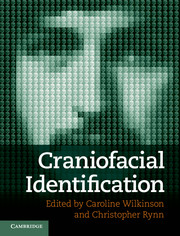Book contents
- Frontmatter
- Contents
- Contributors
- Part I Identification of the Living
- Chapter 1 Familiar face recognition
- Chapter 2 Unfamiliar face recognition
- Chapter 3 EFIT-V
- Chapter 4 Facial recall and computer composites
- Chapter 5 Facial ageing
- Chapter 6 Age progression and regression
- Chapter 7 Computer-assisted age progression
- Chapter 8 Facial recognition from identification parades
- Chapter 9 Virtual human identification line-ups
- Chapter 10 Computer-generated face models
- Chapter 11 Recognising and learning faces in motion
- Chapter 12 Facial image comparison
- Chapter 13 Three-dimensional facial imaging
- Part II Identification of the Dead
- Index
- Plate Section
- References
Chapter 7 - Computer-assisted age progression
Published online by Cambridge University Press: 05 May 2012
- Frontmatter
- Contents
- Contributors
- Part I Identification of the Living
- Chapter 1 Familiar face recognition
- Chapter 2 Unfamiliar face recognition
- Chapter 3 EFIT-V
- Chapter 4 Facial recall and computer composites
- Chapter 5 Facial ageing
- Chapter 6 Age progression and regression
- Chapter 7 Computer-assisted age progression
- Chapter 8 Facial recognition from identification parades
- Chapter 9 Virtual human identification line-ups
- Chapter 10 Computer-generated face models
- Chapter 11 Recognising and learning faces in motion
- Chapter 12 Facial image comparison
- Chapter 13 Three-dimensional facial imaging
- Part II Identification of the Dead
- Index
- Plate Section
- References
Summary
Introduction
Age progression is a technique for increasing the perceived age of subjects’ faces for the purpose of locating missing persons. This is normally accomplished by the manual manipulation of an archive image depicting the subject’s face that was captured at some time in the past. Age progressions may be achieved by hand drawing or by skilful use of photo-editing computer software. Although forensic age progression has historically resided entirely in the domain of the forensic artist, potential improvements in accuracy and execution time can be achieved by combining automated computer-based methods (developed by the researchers in the field of computer vision) with the traditional approach. It is unlikely that age progression could ever be totally automated as the role of the forensic artist extends beyond the task of transforming the face according to generic ageing traits. The forensic artist may use photographs of older siblings for guidance, be required to adapt the age-progressed image to reflect the lifestyle of the subject (e.g. living rough or abusing drugs) or apply bespoke additions such as distinctive clothing or facial hair.
This chapter describes a framework for computer-assisted age progression in which the perceived age of a face image may be increased by manually setting the values of three progression-control parameters that effect (i) changes to facial structure that are associated with generic ageing, (ii) genetic bias (due to similarity to blood relatives) and (iii) fine facial details including wrinkles. The method presented here has been implemented in the Matlab programming language. Future work may include a plug-in for a popular photo-editing package which would provide a valuable tool for forensic artists. In section 7.3, a basic method for generic age progression is outlined. Section 7.4 describes a method for adding genetic bias to the age progression when supporting images of relatives’ faces are available for reference. Section 7.5 shows how the fine facial details associated with ageing may be extracted from a ‘donor’ face image and then applied to an age-progressed face, thereby enhancing the perceived age. Typical examples of age-progressed faces, obtained using the method described, are presented in section 7.6. The effectiveness of our approach in the context of the objectives of this work is discussed in the concluding section.
- Type
- Chapter
- Information
- Craniofacial Identification , pp. 76 - 85Publisher: Cambridge University PressPrint publication year: 2012
References
- 1
- Cited by



